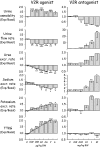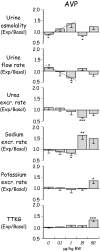Sodium excretion in response to vasopressin and selective vasopressin receptor antagonists
- PMID: 18596120
- PMCID: PMC2518442
- DOI: 10.1681/ASN.2008010021
Sodium excretion in response to vasopressin and selective vasopressin receptor antagonists
Abstract
The mechanisms by which arginine vasopressin (AVP) exerts its antidiuretic and pressor effects, via activation of V2 and V1a receptors, respectively, are relatively well understood, but the possible associated effects on sodium handling are a matter of controversy. In this study, normal conscious Wistar rats were acutely administered various doses of AVP, dDAVP (V2 agonist), furosemide, or the following selective non-peptide receptor antagonists SR121463A (V2 antagonist) or SR49059 (V1a antagonist). Urine flow and sodium excretion rates in the next 6 h were compared with basal values obtained on the previous day, after vehicle treatment, using each rat as its own control. The rate of sodium excretion decreased with V2 agonism and increased with V2 antagonism in a dose-dependent manner. However,for comparable increases in urine flow rate, the V2 antagonist induced a natriuresis 7-fold smaller than did furosemide. Vasopressin reduced sodium excretion at 1 mug/kg but increased it at doses >5 umg/kg,an effect that was abolished by the V1a antagonist. Combined V2 and V1a effects of endogenous vasopressin can be predicted to vary largely according to the respective levels of vasopressin in plasma,renal medulla (acting on interstitial cells), and urine (acting on V1a luminal receptors). In the usual range of regulation, antidiuretic effects of vasopressin may be associated with variable sodium retention. Although V2 antagonists are predominantly aquaretic, their possible effects on sodium excretion should not be neglected. In view of their proposed use in several human disorders, the respective influence of selective (V2) or mixed (V1a/V2) receptor antagonists on sodium handling in humans needs reevaluation.
Figures






Similar articles
-
Vasopressin V2 (SR121463A) and V1a (SR49059) receptor antagonists both inhibit desmopressin vasorelaxing activity.Eur J Pharmacol. 1999 Nov 3;383(3):287-90. doi: 10.1016/s0014-2999(99)00641-x. Eur J Pharmacol. 1999. PMID: 10594321
-
V1a- and V2-type vasopressin receptors mediate vasopressin-induced Ca2+ responses in isolated rat supraoptic neurones.J Physiol. 1999 Jun 15;517 ( Pt 3)(Pt 3):771-9. doi: 10.1111/j.1469-7793.1999.0771s.x. J Physiol. 1999. PMID: 10358117 Free PMC article.
-
Nonpeptide antagonists for vasopressin receptors. Pharmacology of SR 121463A, a new potent and highly selective V2 receptor antagonist.Adv Exp Med Biol. 1998;449:427-38. Adv Exp Med Biol. 1998. PMID: 10026834 Review.
-
Characterization of SR 121463A, a highly potent and selective, orally active vasopressin V2 receptor antagonist.J Clin Invest. 1996 Dec 15;98(12):2729-38. doi: 10.1172/JCI119098. J Clin Invest. 1996. PMID: 8981918 Free PMC article.
-
Nonpeptide vasopressin receptor antagonists: development of selective and orally active V1a, V2 and V1b receptor ligands.Prog Brain Res. 2002;139:197-210. doi: 10.1016/s0079-6123(02)39017-4. Prog Brain Res. 2002. PMID: 12436936 Review.
Cited by
-
Transtubular potassium gradient predicts kidney function impairment after adrenalectomy in primary aldosteronism.Ther Adv Chronic Dis. 2020 Aug 27;11:2040622320944792. doi: 10.1177/2040622320944792. eCollection 2020. Ther Adv Chronic Dis. 2020. PMID: 32922714 Free PMC article.
-
H,K-ATPase type 2 contributes to salt-sensitive hypertension induced by K(+) restriction.Pflugers Arch. 2016 Oct;468(10):1673-83. doi: 10.1007/s00424-016-1872-z. Epub 2016 Aug 25. Pflugers Arch. 2016. PMID: 27562425
-
Subtypes of Neurohypophyseal Nonapeptide Receptors and Their Functions in Rat Kidneys.Acta Naturae. 2020 Jan-Mar;12(1):73-83. doi: 10.32607/actanaturae.10943. Acta Naturae. 2020. PMID: 32477601 Free PMC article.
-
Is mild dehydration a risk for progression of childhood chronic kidney disease?Pediatr Nephrol. 2024 Nov;39(11):3177-3191. doi: 10.1007/s00467-024-06332-6. Epub 2024 Apr 18. Pediatr Nephrol. 2024. PMID: 38632124 Free PMC article. Review.
-
Vasopressin in chronic kidney disease: an elephant in the room?Kidney Int. 2009 Nov;76(9):925-8. doi: 10.1038/ki.2009.325. Kidney Int. 2009. PMID: 19829311 Free PMC article.
References
-
- Schafer JA: Abnormal regulation of ENaC: Syndromes of salt retention and salt wasting by the collecting duct. Am J Physiol Renal Physiol 283: F221–F235, 2002 - PubMed
-
- Humphreys MH, Friedler RM, Earley LE: Natriuresis produced by vasopressin or hemorrhage during water diuresis in the dog. Am J Physiol 219: 658–665, 1970 - PubMed
-
- Buckalew VM, Dimond KA: Effect of vasopressin on sodium excretion and plasma antinatriferic activity in the dog. Am J Physiol 231: 28–33, 1976 - PubMed
Publication types
MeSH terms
Substances
LinkOut - more resources
Full Text Sources
Molecular Biology Databases
Miscellaneous

